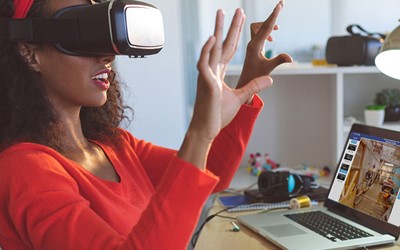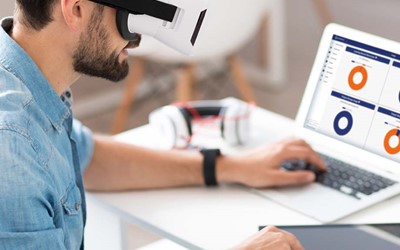How can VR be used to train your employees
Virtual Reality technology is becoming increasingly common in the workplace for training purposes. It enables organizations to carry out training in a simulated environment that accurately reflects settings.
This means that employees can be trained to deal with the real life challenges they will face in their role, as well as enabling potential employees to be assessed for aptitude, skills and knowledge before they are offered employment. And it’s not just about learning hard skills like working machinery, there is actually a lot of different training use cases where VR can add value.
Posted 7 September 2022
VR is being used by organizations to train employees how to:
- Operate new machines and equipment
- Execute a new process successfully and efficiently
- Build empathy towards customers and colleagues
- Deliver difficult messages
- Negotiate confidently
- Communicate and present effectively
- Effectively convert more sales
- Improve customer service
- Manage difficult customers
- Develop leadership skills
- Deal with emergencies
Employees that are better trained in the above areas perform more effectively in their job and require less supervision and coaching overall. They also perform better in any future roles and progress much faster.
At the moment, the two main alternatives are classroom-based training or eLearning. Both have their good points. Classroom is great for discussions, hands-on interactions and role play activities but it’s not always accessible to everyone and it can be difficult to scale due to cost issues, logistics and catering to all your staff’s geographical needs.
On the other hand, eLearning is very scalable as it can be delivered through an employee’s laptop or smartphone and be accessed on demand anywhere in the world which cuts out a lot of costs. Although eLearning is engaging in its own way, it can’t put you in a true to life situation the way that VR can.
VR is particularly good at training on practical and soft skills.
What are practical and soft skills?
Practical skills include, physical skills, people skills, creative skills and hard/soft skills. It basically means any skill that is performed by hand as in using equipment, tools or technology that requires any guidance, force or movement.
Soft skills include things like leadership, communication, problem solving ability, social skills, time management, work ethics and many more things. Soft skills are different practical skills as they deal more with the are more character traits and interpersonal skills a person displays in their dealings with others.
Why VR?
VR offers the best of both worlds. It’s a well-balanced learning solution which is in many cases more cost effective than classroom-based training and also has more flexibility as it can be accessed anytime anywhere. VR gives users the ability to make choices that are more in line with how they would behave in the real world, since the learning environment offers them a more well developed virtual scenario.
Before VR, learners being trained to operate dangerous equipment would receive their training in the form of watching videos, reading information and studying manuals, but not actually perform the tasks on the equipment itself until actually on the job. VR changes the game. You as an employer have the reassurance that employees will be trained to use the equipment safely and that they will not break your expensive equipment, since by the time they come to use it for real, they already know how to do so correctly. It cuts out risk and gives them proper experience and feedback on their choices.
If you have read anything about VR training you will probably be familiar with the no risk aspect, but what if your organization doesn’t have anything unsafe? The good news is VR does so much more.
Remember we talked about soft skills earlier in the article? VR is a wonderful way to help your employees or potential candidates with a variety of training needs. For example, VR simulation can provide a low-pressure way to practice having high-stakes conversations. Many companies in particular in the customer service sector are using VR to help entry-level employees learn how to deal with complex, emotionally charged phone calls without having to deal with real life angry customers. Not only does this allow them to get practice in a variety of scenarios, it also helps them get instant feedback from trainers. VR can also help managers develop presentation skills and evaluate a current employee’s skills.
VR- powered education and training is set to be a turning point for the next generation of workers helping them with every aspect of learning and assessment - an all-round tool that is available on demand no matter where your workforce is located.
30-day FREE Trial of eNetReality
Start your VR experience today and begin to quickly develop and create your own fully-immersive assessments - no coding required!
Recent Posts
Benefits of Online Assessment for Awarding OrganizationsDriving your performance and compliance
Enhancing compliance through performance management and digital learning solutions
10 Reasons Why You Need A Digital Learning Solution in Your Workplace
Mastering remote & hybrid learning with analytics



